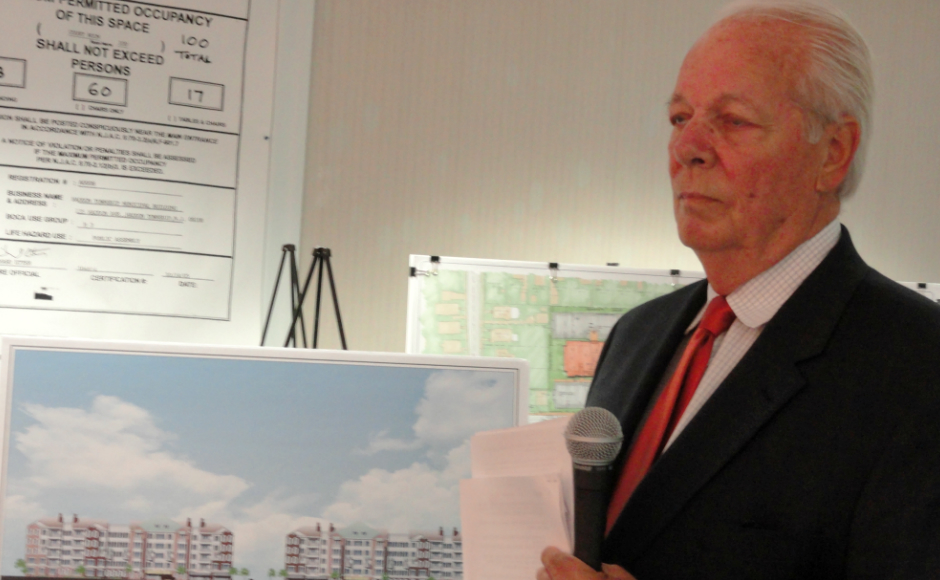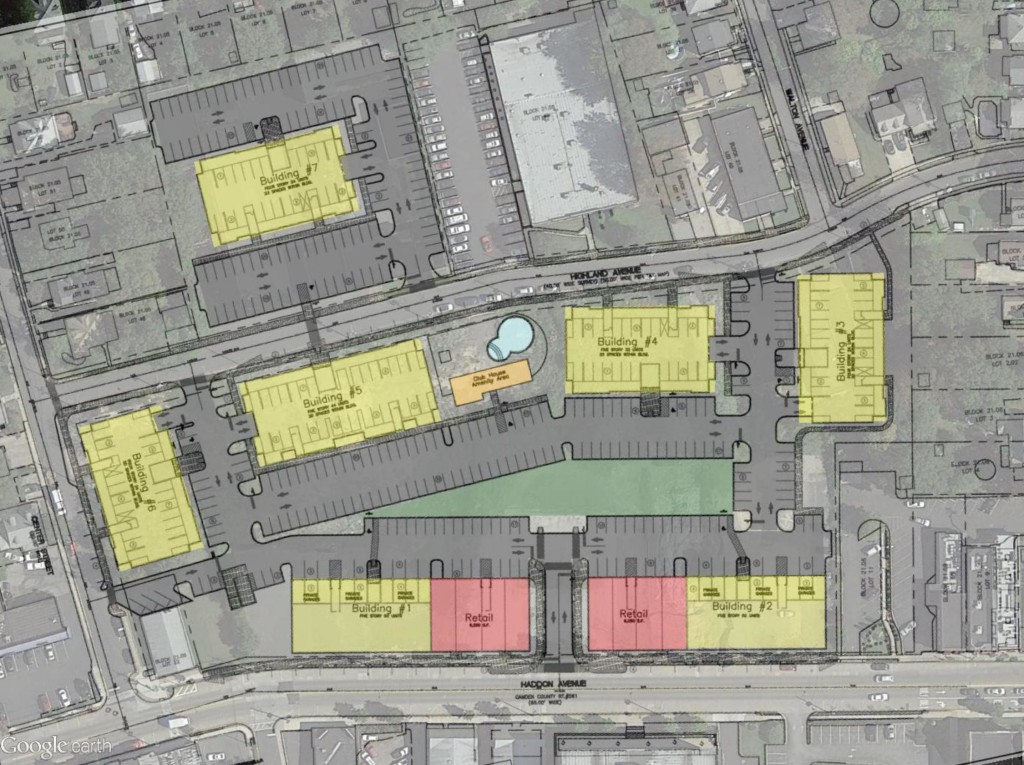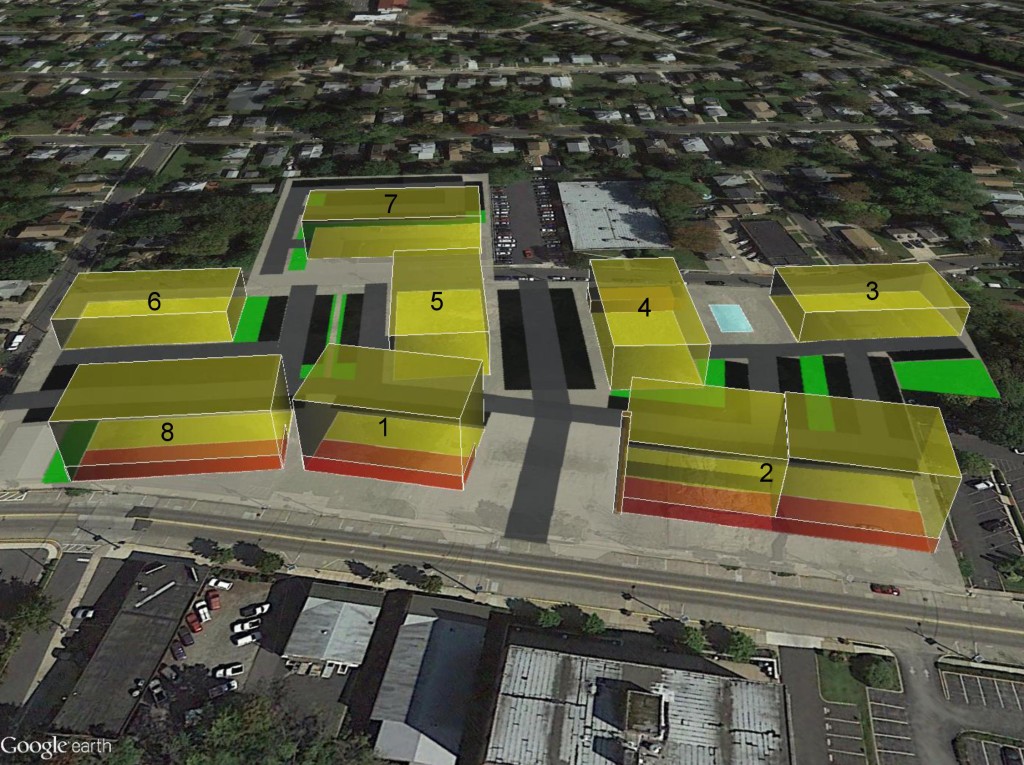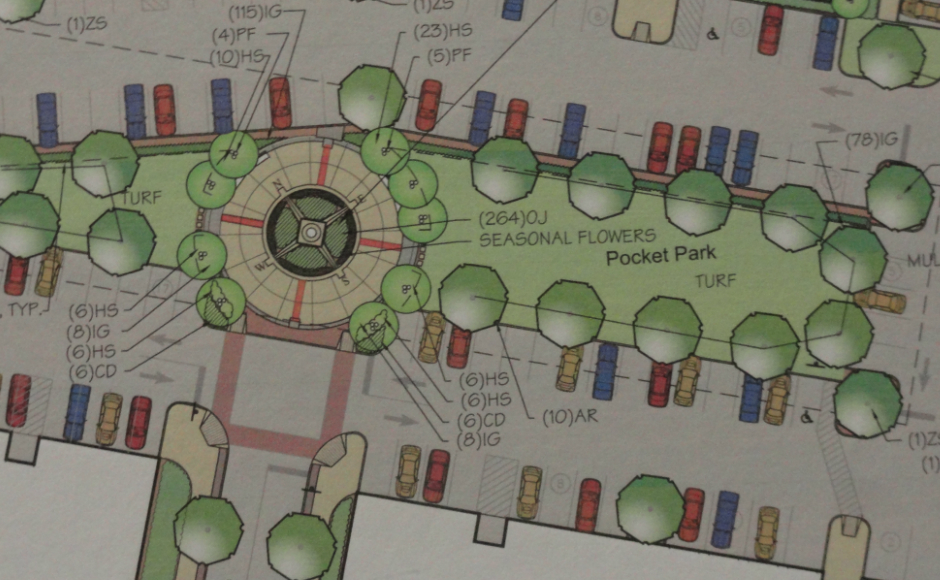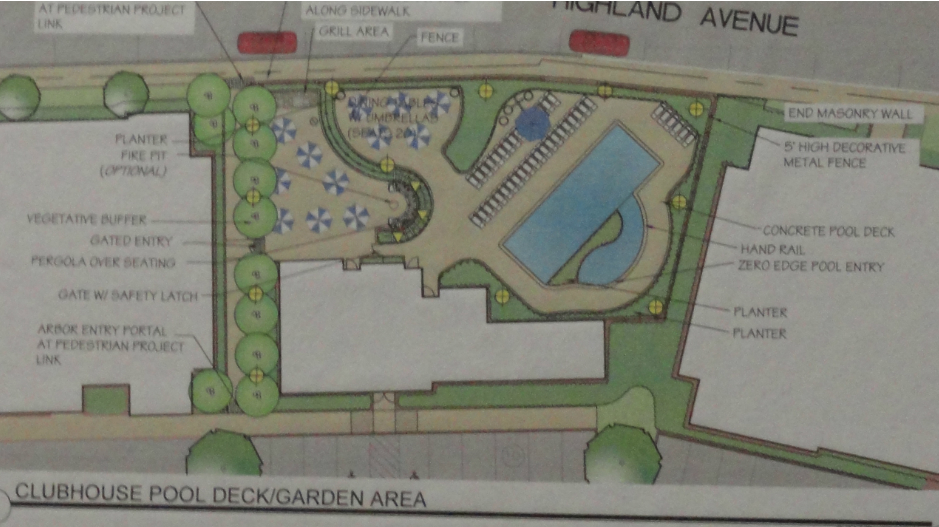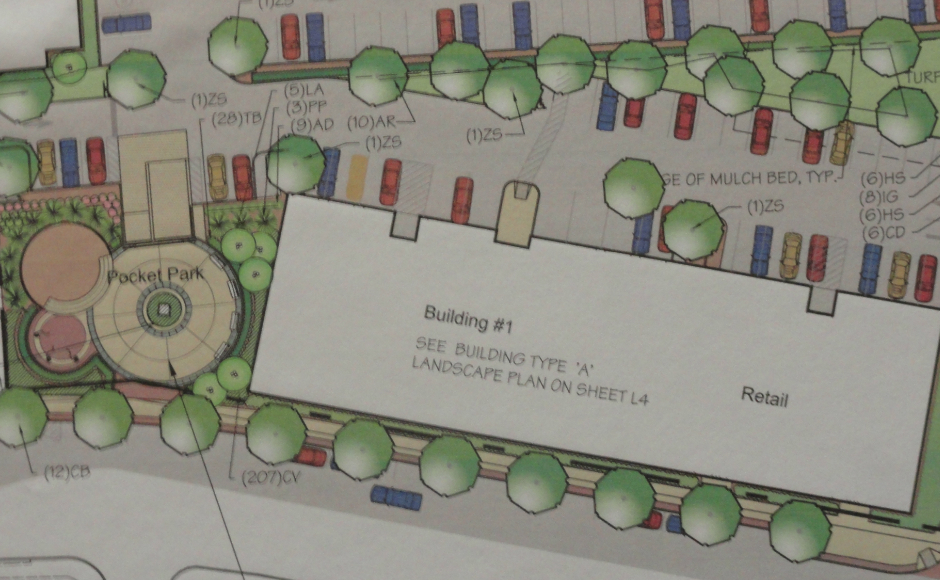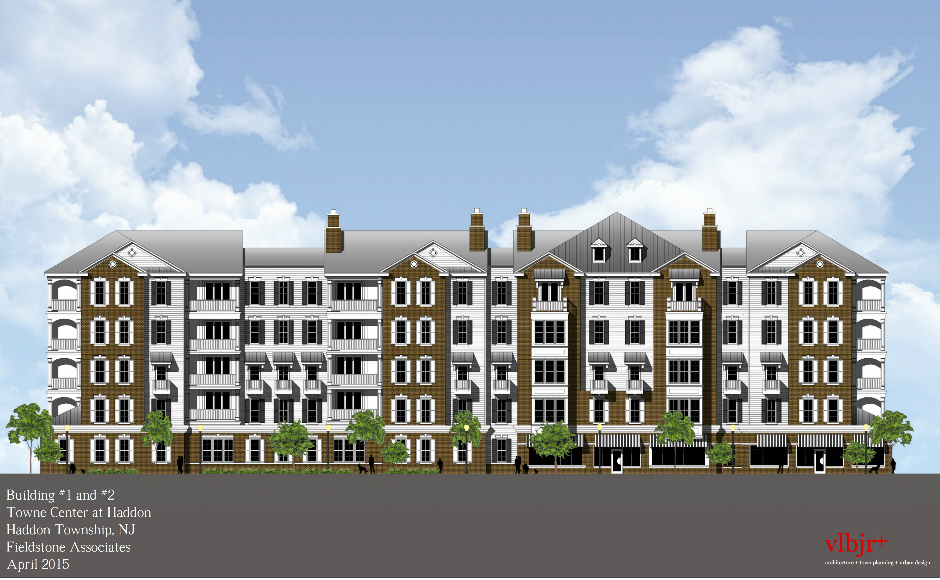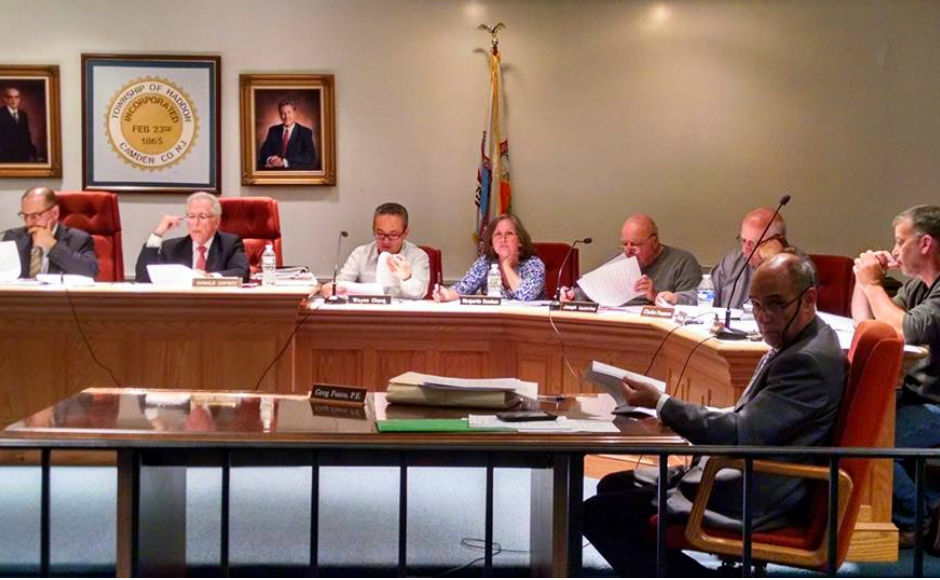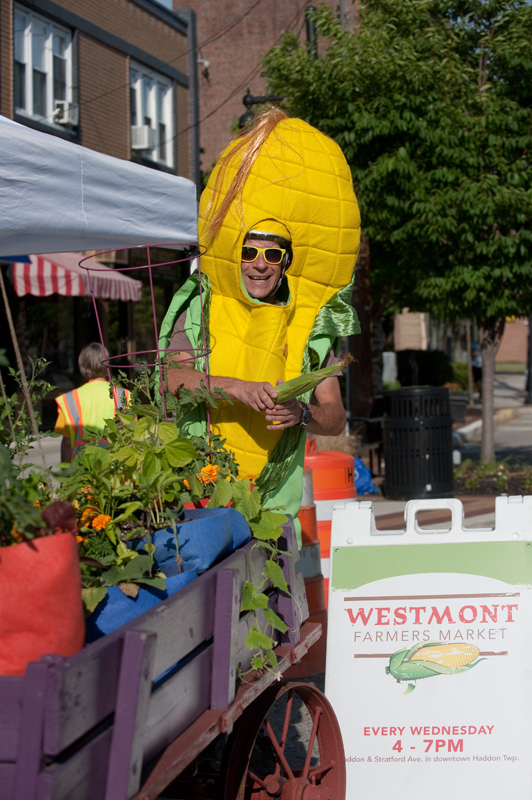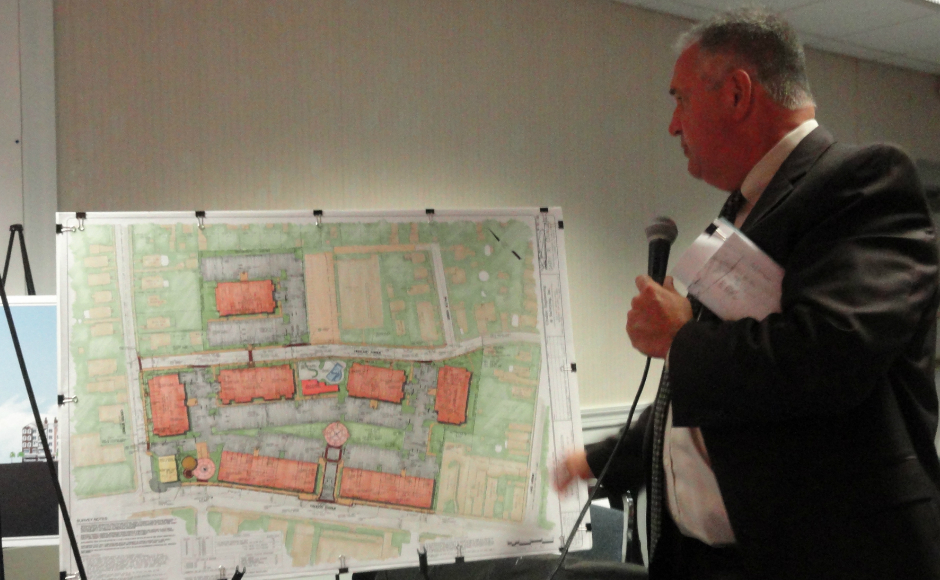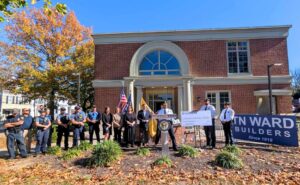Amid public criticism of the proposed final site plan for its redevelopment, the Planning and Zoning Board asked developer Fieldstone Associates to make some changes.
By Matt Skoufalos
“You have an application in front of you,” attorney Richard Goldman told the Haddon Township Planning and Zoning Board Thursday night.
“We designed that application based upon a redevelopment plan ordinance that was adopted by this commission,” Goldman said, on behalf of developer Fieldstone Associates. “We complied with that plan 100 percent.”
Revised plans for the Haddon Towne Center project are consistent entirely with the negotiated terms of a settlement among Fieldstone, the township, and Fair Share Housing, Goldman said. On the strength of those technical requirements, the developer was seeking both preliminary and final approval for its site plan.
The reason for the meeting, Goldman said—aside from being another condition of that negotiated settlement—is because “the town, as a part of our redevelopment agreement, has to decide whether our agreement is consistent with the redevelopment of the community.”
He then spent the next three-and-a-half hours arguing against changes proposed by members of the community, refusing outright to redesign the project, and insisting that his clients “are not prepared to come back” for another meeting with the community.
By 11:15 p.m., an exasperated Goldman returned to the strength of those technical requirements in a final appeal to the board (“This isn’t a tribal council,” he snapped in his closing remarks). But by then the body was bound by its own bylaws to defer any action on the business before it, the discussion having passed its internal, 11 p.m. threshold.
What will befall the project next hinges on the appetites of residents to make it what they will.
Chutes and ladders
The big asks from the public on Thursday were: to make the property more walkable; to keep the first floor units of its Haddon Avenue-facing buildings exclusively commercial and not residential; and to give it a sense of place that is appropriate to the community in which it is situated.
Haddon Township resident Jason Miller offered a handful of suggestions on how to improve the feel of the project while maintaining its critical parameters in an extensive document provided to both Fieldstone and township leaders. The developers refused to entertain discussion on his work.
Their arguments hinged on costs (“We’re going to put $50 million into building this,” Goldman said) and time invested in the project (Goldman’s escalating narrative on the length of the project began at 11 years in his opening remarks and had increased to 12-and-a-half by his summation), but what both the board and the developer truly fear is the case moving back to court.
Haddon Township Mayor Randy Teague has repeatedly voiced his discomfort with the township being exposed to either an affordable housing lawsuit or a builder’s remedy lawsuit. Teague has said that any failure of the legal settlement brokered with Fieldstone could hypothetically allow a new developer to come and build an ultra-high-density project comprising entirely affordable housing units.
The likelihood of that scenario is one that nobody seems able to predict, however. Fieldstone testified that it will not receive tax credits for the affordable units it is creating on the site, and has repeatedly claimed that the entire financial projections for the build are threatened by the inclusion of even 25 affordable units. It therefore strains credibility to think that either Fieldstone or another developer would suddenly decide that an ultra-high-dense, entirely affordable-housing-unit construction is a profitable venture in the same location.
‘This isn’t their best work’
What’s left is the opportunity for collaborative enterprise among the developer, the governing body, and the community, but prior efforts to broker those talks have fallen short.
Haddon Township resident Jack Glazebrook, who weeks ago met with Fieldstone, Teague, and other residents to offer constructive criticism of the site plan, said that the input he offered the developer was not present at all in the proposal put forth on Thursday.
“This is an incomplete design,” Glazebrook said. “This is certainly still a draft, and it would be a travesty if it were approved. This isn’t their best work. This isn’t their architect’s best work. It’s a draft. It’s incomplete.
“We need to start talking about how people are going to use this space,” he said. “If there was enough [commercial] space, P.J. Whelihan’s, Treno would start using this space. Right now, it’s just not good.”
For the first time last night, the public got a look at a list of amenities Fieldstone proposed for the project. Landscape architect Joseph Adamson spoke about elements in his design of the site that are intended to “provide urban character.”
They included “a blank plaza containing some artwork,” a 10-foot-by-10-foot, vertical water wall, a raised mini-amphitheater, and a “flag plaza,” ostensibly similar in intention to the memorial monuments housed at the nearby Westmont Fire Company #1.
On Adamson’s plans, those elements are not arranged in a central location at the site, but are rather tucked away in pockets of space. The central pedestrian walkway is an island of green surrounded by parking lots, upon which Adamson said the developer will install “an art plaza that is going to provide the connection of the community to look out over what would be a linear greenspace.”
Fieldstone also introduced a tenants-only clubhouse for the first time on Thursday, placed between Buildings #4 and #5. It contains a walk-in pool, a sun deck with an overhead trellis, firepit, and shade structures accessible only to renters. Adjacent to that clubhouse are “a gallery of trellises and vegetation” Adamson said would connect the space to Highland Avenue and Building #7.
The board questioned Fieldstone architect Victor L. Barr, Jr. about linking the clubhouse to architectural details along the Haddon Avenue frontage of the property while also noting that its dimensions would have to be scaled back by two feet to comply with local setback ordinances.
But none of its members asked how the public-square intention of a town center is enhanced by the placement of a private clubhouse for renters; or why, with the Crystal Lake Pool mere blocks away, residents would desire access to a similarly public (restricted) pool.
And again, the question of how these elements engage the public resurfaced repeatedly throughout the conversation.
“There’s a lot of talk about some of the landscaping and how the sidewalk interacts with where the sidewalk is,” said Collingswood resident Joseph Russell, who submitted design suggestions to the developer through Teague. “If people are going to be using this as a transit-oriented development, they’re going to be walking all over it,” he said. “We can’t just landscape things where there should be sidewalks.”
“It should be an active area that people can get through in cars and on bikes,” Miller said. “It seems like a gated community.”
Collingswood resident Shawn Burke described how interest in the project is not confined exclusively to the residents of Haddon Township, emphasizing how the project has an opportunity to present the best face for the community to its neighbors who will visit, shop, and possibly work there.
“People want the project to be a part of the fabric of Haddon Township,” Burke said. “They want it to be walkable; they want it to be great. They don’t want something that feels like a bubble.
“This is just a big shift in the way we live, both in this region and this country,” he said. “I think the times are just changing and people are just demanding different things. They’re demanding sustainability; they’re demanding walkability. They don’t want to feel isolated.
“People just genuinely want the best project that this can be,” Burke said. “They see that this architect and this developer are capable of really good stuff. Why are other towns getting that stuff? This project is going to outlive all of us in this room. I hope that the developer has some patience left and is willing to make improvements.”
‘If we’re going to do it right, let’s do it right’
By the end of the evening, the board had wrangled a pair of loosely formed concessions from Fieldstone: Haddon Township architect Wayne Chang would collaborate with Barr and Fieldstone principals Arthur Corsini and Kenneth Pizzo to make the edifice of the Haddon-Avenue-facing buildings more architecturally interesting, and the developer agreed to add a few additional crosswalks and pedestrian features somewhere in the property to aid walkability.
But Fieldstone representatives were not at all interested in any of the proposed modifications that Miller presented in terms of setting back the buildings to create more sidewalk space, adding a central boulevard that could be closed off for open-air public events, or adding in first-floor retail frontage along Haddon Avenue instead of residential units.
In the end, the developers did not leave the meeting with either preliminary or final site plan approval. The board deferred further discussion to a special meeting on Monday, October 19.
“In all likelihood this project is going to be built, and it’s going to be approved,” said Planning and Zoning Board Chair Richard Rotz at the end of the meeting. But he also encouraged Fieldstone to consider the input from residents in its meetings with Chang.
“Some of the suggestions might be worth considering, and might not be something that would necessarily derail your design,” Rotz said.
“I don’t think this project’s going to rise and fall on a memorial park, but some of those comments might be some things that, when you meet with Mr. Chang, should be considered.”
“If we’re going to do it right, let’s do it right,” said board member Linda Rohrer. “I would rather feel for myself personally and the residents of Haddon Township that we have done the best job we can to give the public their input.”
Even Fair Share Housing attorney Kevin Walsh, who helped negotiate the legal settlement among Fieldstone and Haddon Township, said in a phone conversation Friday that the power to influence the outcome of the conversation at this point lies entirely with the planning and zoning board.
“From a legal standpoint, we support good design; we don’t have legal hooks to advocate for that,” Walsh said. “That’s the town that figures those things out. Our hope and our expectation is that they’ll sort these things out in a way that gets to 25 affordable units.”
The question at this point will be kicked back to the citizens of Haddon Township. The board has demonstrated its receptiveness to hearing public comment on the proposal. Members of the public have offered feedback on ways to improve its design. In his capacity as a Haddon Township resident and private citizen, the author of this story testified that the community deserves a project worthy of breaking ground in the year of its 150th anniversary.
This redevelopment has the potential to unify the town around a central square that could be used for public gatherings, block parties, farmers markets, outdoor events, beer gardens, food truck festivals—you name it.
It could be a place that inspires greater interest in the adjacent local business and professional district; that creates a sense of identity for a community distributed across major county roads and throughways. It could be a housing project that welcomes renters as valued taxpayers and contributors to the local social fabric.
But not in its current state.
In deferring action Thursday, the board gave the residents of Haddon Township two-and-a-half more weeks to put its stamp on the project. Eighteen days to muster feedback, write letters, float ideas, and dream of what might be. It’s not a lot of time, but it’s a gift nonetheless. What comes next is up to the people who choose to accept it.
Neither side wants to experience a lengthy legal battle, and certainly not after years of the same. But neither should the threat of additional legal action cow the people of Haddon Township from contributing to the design of the town(e) center that they ultimately want to anchor their community.
People who wanted the project to contain market-rate individual town homes and condominiums are going to be disappointed with the project.
People who wanted the project to be an urbanist playground of limited parking, ultra-dense mixed uses, and eco-conscious building materials are going to be disappointed with the project.
People who wanted the project to contain a sense of interest in the community it will anchor for the next several decades should not have to be disappointed in it.
Throw out the fact that Fieldstone’s traffic expert, David Shropshire, presented recommendations based on data most recently gathered in 2012 (the original study dates back to 2005, he said); or that his answer to questions about how traffic would flow from the site was that “some of the streets naturally will take on additional volume.”
(Throw out, too, the fact that neither the township nor the developer requested a study of how travel times could be affected by adjusting the traffic lights along Haddon Avenue to compensate for the additional volume.)
Throw out the fact that Fieldstone has not publicly presented any updated analysis on the impact to the school district from the addition of 252 apartment units in a community with neighborhood elementary schools.
Throw out objections to the appearance of the project, particularly along the Haddon Avenue side, about which Rotz and board counsel Donald Cofsky challenged Barr extensively in the course of the conversation.
(A sample of that exchange:)
COFSKY: Where’s the individuality that you presented? When it was first approved, it was a beautiful design. Where’s the individuality that’s being referred to here?
BARR: The variety of the roof form breaks the building into individual segments.
COFSKY: They keep repeating themselves.
BARR: There’s not an element of the building—there’s details that keep repeating.
COFSKY: Did you have the opportunity to look at the original design that was approved by this board? Does this in any way resemble that?
BARR: That was a for-sale condo project.
(and also:)
GOLDMAN: When you design a building to a different ordinance, it will have a different outcome. It’s our opinion that we do comply with the two-foot wall offsets at least every 40 feet.
ROTZ: The ordinance also requires that it meets design standards. We’ve been talking since the beginning of this project about using a substantial amount of brick in this project. This is a much more cheaper design that has been presented, taking advantage of this project.
GOLDMAN: Let’s keep in mind that this project now supports 25 additional units–
COFSKY: It’s called polishing the toe of the boot.
GOLDMAN: That’s why we have ordinances, because beauty is in the eye of the beholder.
COFSKY: It’s been repeated time and again: is this something that’s appropriate and in keeping with Haddon Avenue? Is this the jewel of Haddon Avenue?
You can even throw out the pass-the-buck, chicken-and-egg question of with whom blame for the project in its current state ultimately lies—(a prior administration’s use of eminent domain! the absence of timely public input into the process! the abdication of responsibility by COAH! the collapse of the housing market!)—because at this point, fatigue has set in.
Virginia Avenue resident John Leon summed it up precisely in his comments to the board on Thursday.
“The project that you’re voting on tonight is a product of a broken system,” Leon said. “You know you’re in trouble when your own mayor says, ‘We’re approving this not because it’s a great development, but because we have to.’ It’s not anybody’s fault that’s sitting here, but it’s the product of a broken system; the threat of a builder’s lawsuit and an all-affordable-housing building, which nobody wants. This developer came to you with a plan and said, ‘Here’s my plan, you can approve it or we go back to court. Don’t change anything,’ and nothing’s been changed.
“Counsel’s not prepared to come back,” Leon said. “Some people would call that arrogant. A gun was held to our head, and this project was approved. The only question is whether you’re going to exercise your obligations to do what’s right for the citizens of this town and fully vet this project. They’ve got a lot of money in the project, and the town has a lot of money in the project.
“But we were here first.”
Get more local news that matters. Check out NJ Pen on Facebook and Twitter, [tinypass_offer text=”or click here to become a supporter.”]
